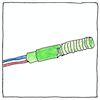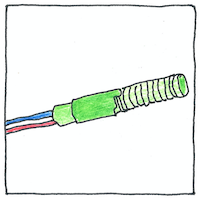Carl Wilhelm Siemens
thermometry

|
Resistance thermometer
In 1821, Humphry Davy had observed that conductance of metals varied according to temperature but Davy hadn’t shown that this property could be used to make a thermometer. In 1871, Carl Wilhelm Siemens claimed that platinum would be the best metal for a resistance thermometer, having the most stable relation between resistance and temperature over the greatest range.
How to calibrate
Adjust the sensor to give an accurate reading for a known state of a pure substance, such as the triple point of water. Adjust the sensor to replicate the readings of another sensor that is known to be accurate. Be sure to calibrate the sensor over the range of temperatures in which the sensor is intended to be used.
Resistance behavior
When a delicate wire gets really hot, it melts, making its resistance a moot question. When it gets incredibly cold, its resistance becomes independent of temperature. Ideally, behavior depends on principles, but in practice can randomly misbehave.



Resistance thermometers can be designed for temperatures between −328 and 932 °F. Outside of that range, resistance becomes non-linear or doesn’t depend on temperature. Most resistance thermometers are designed to work immersed in the environment or liquid that they measure; later, Samuel Pierpont Langley showed, with a similar design, the ability to determine a temperature at a distance.
Carl Wilhelm Siemens, without a criminal intent, also became known as Sir Charles William Siemens.
See also in The book of science:
Readings in wikipedia:
Other readings: